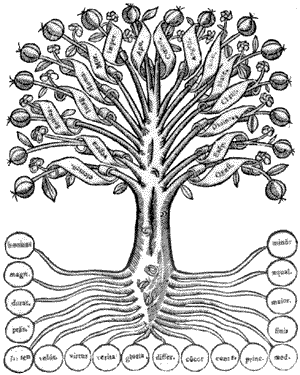Gegenwärtigen, Gegenwärtigung, Gegen-wart, Gegenwart, présentifer, présentification, être présent à, pré-sent, pre-sente, atualmente presente, presentación
Tempo gramatical do presente. A partir de SZ p. 326 ; n.p.c. Gewärtigen et Vergegenwärtigung.
«presentación»: en alemán, «Gegenwärtigen», Heidegger llama «presentación» el modo temporario del ser que aparece como pura presencia. (Rivera; STRivera:Notas)
Como o ser-aí nutre expectativas a partir do factível (Tunlichen), aquilo com o que ele lida se encontra em seu presente (Gegenwart). O compreender-se (Sichverstehen) é co-originariamente com o futuro (Zukunft) e o ter sido (Gewesenheit) uma presentificação (Gegenwärtigen). A presentificação do compreender impróprio (uneigentlichen Verstehens) predominante no ser-aí ainda nos ocupará em seguida de maneira particular. Precisamos dizer de maneira negativa: o presente (Gegenwart) do compreender impróprio não tem o caráter do instante (Charakter des Augenblicks), porque a temporalização (Zeitigung) desse modo do presente se determina a partir do futuro impróprio. O compreender impróprio tem por conseguinte o caráter da expectação que esquece e presentifica (Charakter des vergessend-gegen-wärtigenden Gewärtigens). (GA24MAC:422)
The most general and immediate determination of the τέλειον is that beyond which there is nothing (worüber hinaus nichts) to apprehend, in the sense that a being-character comes to expression therein. Τέλειον is not a being as a being, but rather as way of being. Shoes, work tools, and so on, ὑποκείμενα, all of these beings are τέλη only when their being-character is thereby made explicit; that by which a definite handiwork reaches its end genuinely is. The beyond-which-nothing (Worüber-hinaus-nichts) is not being-completed (Fertigsein) in a negative sense of being-toward-the-end (Zu–Ende-Seins), but is to be taken in the positive sense as constituting the genuine there. The τέλος is in such a way that it maintains the being in its presentness (Gegenwärtigkeit). The sense of being (Sinn von Sein) is determined by this being-present (Gegenwärtigsein). (GA18MT:64)
In ἐμπειρία the referential connection (Verweisungszusammenhang) of the as soon as-then is given, and it expresses a providing of something that is made present, a producing. To the extent that ἐμπειρία is sustained, this connection gets modified into the “as soon as such and such, then always so and so,” which for its part is modified, in repetition, into the if-then, the because-therefore. Thereby the what-connection (Waszusammenhang) is extracted as such. That which is presentified in the presentification (Gegenwärtigung) of the referential connection is given in each case in its εἶδος and specifically within the referential connection itself. For in τέχνη that which is at issue becomes understandable according to its outward look, in such a way that the foundation of the relation can be read off from this concrete connection. Ultimately, the presentification of the referential connection of the as soon as-then (Sobald das
– dann das), or of the as soon as-then always, is preparatory for the disclosure of beings out of their ἀρχή. The ἀρχή is indeed the whence and is always already there. Thus the presentification of this connection is in the last analysis preparatory for making beings disposable in their presence (Anwesenheit) (οὐσία), in a disclosive return (Rückgang) to that which is already there, the ἀρχή. (GA19RS:53)
VIDE: Gegenwärtigen
atualização (SZ)
présentifier (EtreTemps)
making present (BT)
VIDE Gegenwart
NT: Making present (Gegenwärtigen), 26, 105fn, 326-328, 338-339, 342, 344, 346-350, 353-357, 359-360, 363, 363 n. 22, 365-366, 369, 381, 391, 406-410, 413-414, 416-418, 420-422, 425; making-unpresent, 355. See also Present; Temporality, inauthentic (BTJS)
NT: ‘. . . des reinen “Gegenwärtigens” von etwas’. The verb ‘gegenwärtigen’, which is derived from the adjective ‘gegenwärtig’, is not a normal German verb, but was used by Husserl and is used extensively by Heidegger. While we shall translate it by various forms of ‘make present’, it does not necessarily mean ‘making physically present’, but often means something like ‘bringing vividly to mind’. (BTMR)
Gegenwärtigen: «presentar», «hacer presente» (o «presentificar»). En Ser y tiempo, el «presentar» plasma el éxtasis temporal impropio de la caída. Cabe recordar que, en la impropiedad, pasado, presente y futuro maduran (zeitigen) como «olvidar» (vergessen), «presentar» (gegenwärtigen) y «estar a la espera» (gewärtig sein). Así, cuando el Dasein hace presente un ente, corre el riesgo de quedar absorbido en el ser de los entes. El Dasein se olvida entonces de las posibilidades de su ser y cae en el tiempo del estar-a-la-mano (Zuhandenheit) y del estar-ahí-delante (Vorhandenheit). En la resolución (Entschlossenheit), el Dasein puede recuperarse de la caída a través del instante (Augenblick) de la decisión, que es el éxtasis del presente en la temporalidad propia. Véanse las entradas Gegenwart (die) y Zeitigung (die), zeitigen. (GA64, pp. 63, 64 (lo presentante de la ocupación), 65 (el ser temporal del ocuparse), 68 (ocupación presentante), 69-70, 73 (estar en el mundo en la modalidad del presente), 75-77; GA21, pp. 192 (presente), 207 (ser = presencia), 400-402 (estructura del ahora), 405, 407, 409-415, 411 (ahora = presente), 414-415; GA2, pp. 328, 338-339, 342, 346-350, 369, 410).) (LHDF)
(…) il faut donc comprendre cette présentification dans son acception temporelle de « rendre présentement présent ». (Auxenfants; ETJA:§6)
